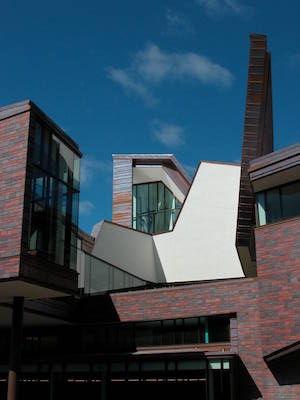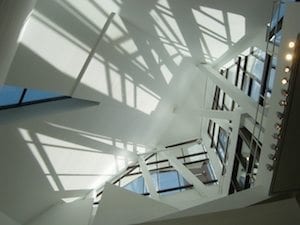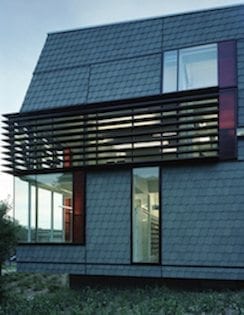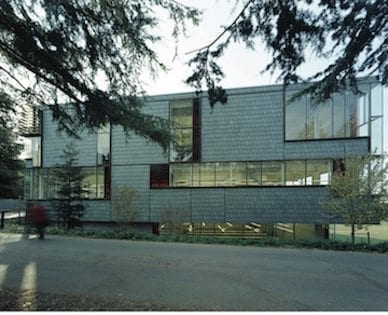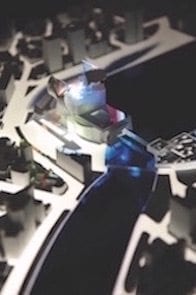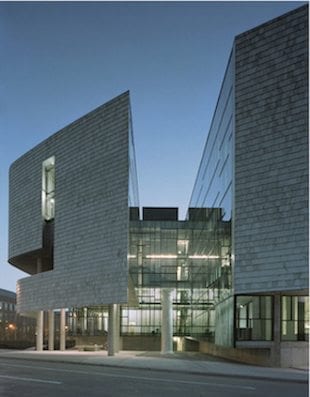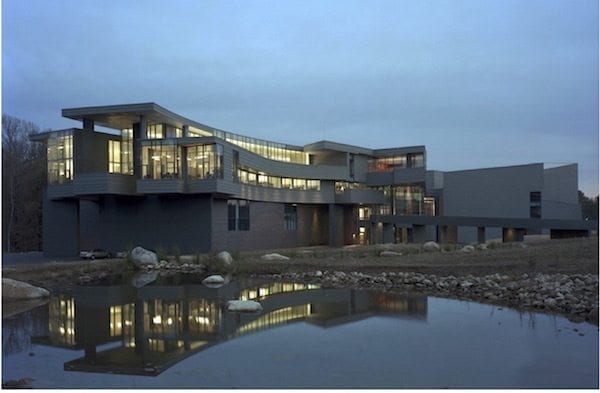
Carroll A. Campbell Jr. Graduate Engineering Center, Clemson University (Photo: ©Tim Hursley)
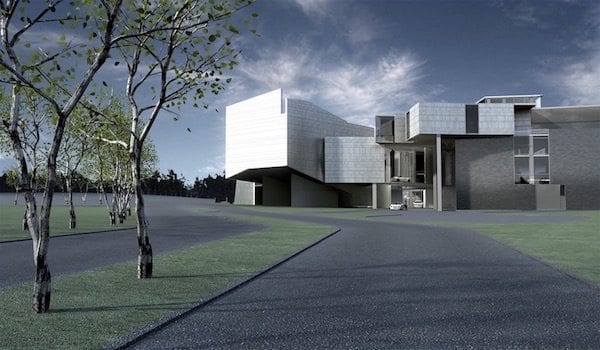
Carroll A. Campbell Jr. Graduate Engineering Center, Clemson University (2004) Rendering courtesy Scogin Elam
COMPETITIONS: You were both working for a very successful, large architecture firm in Atlanta when you decided to go off on your own. How does one decide on the right moment to open an office and go it alone? Some may have a commission waiting for them. What led you to choose that moment?
Merrill Elam: That wasn’t the case with us. We didn’t have anything; we had to sign no-compete clauses for four years covering any past or prospective clients.
Mack Scogin: We were not young architects starting out on our own. We had worked there (Heery and Heery) for 17-18 years. The firm had 35 people when we started, and it was 500 when we left. It was a fantastic experience, one which very few people get today. It was a case where young people were involved in the growth and expansion of a very diverse and dynamic organization. Why did we leave? The kind of decision-making around projects at that scale of organization became very involved with the kind of continued growth and survival of the organization. Basically, you end up making decisions based on 500 different agendas. Under those conditions, it’s very difficult to do personal work.
We were spending a huge amount of time trying to do personal work and also trying to manage that organization and make sure it was healthy. We had 20 years of fantastic experience, and we were curious as to how we might apply that to our own work, where we would have more hands-on control over it.
ME: Isn’t it also fair to say that it was a moment with that company where the ownership of the company began to change?
COMPETITIONS: Early on you entered a competition for the Ft. Lauderdale Waterfront Competition and did quite well with a second place. Young firms quite often start by entering competitions to establish a reputation. Was that the case here?

Ft. Lauderdale Riverfront Downtown Competition (Second Place, 1984)
MS: At that time we did almost no competitions. This was a firm (Heery) that was dedicated to issues around time and cost control and how you deliver projects to clients and satisfy our clients’ needs. In the years we were there, we did only three or four competitions, and most of those were done in the last few years we were there, when we were making the decisions as to whether to do them or not. The Fort Lauderdale competition was strictly volunteer time, and I’m not sure we know what we would have done had we won it, since it was so far off the pallette of the kind of projects that we did. So we got a group of people together who wanted to do something different and just learn from the experience. We came in second, took the money that we won and had a great party.
“That competition, as well as several others, were quite revelatory experiences for the people at the firm. To this day, I think it’s some of the most interesting work we ever did. People who have recently seen it say that it was some of the most interesting work ever done by the firm, up to the present. It gave us a hint that we could possibly do something that was outside the norm. To this day, we are still very proud of all that work. All of them were volunteer work.
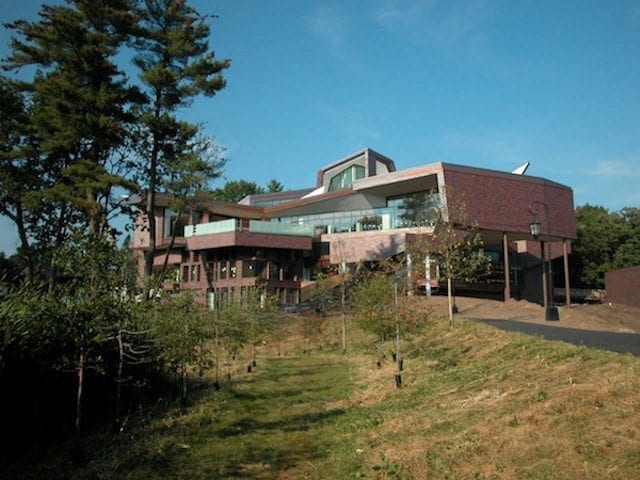
Exterior view, Wang Campus Center, Wellesley College

View to exterior of parking garage
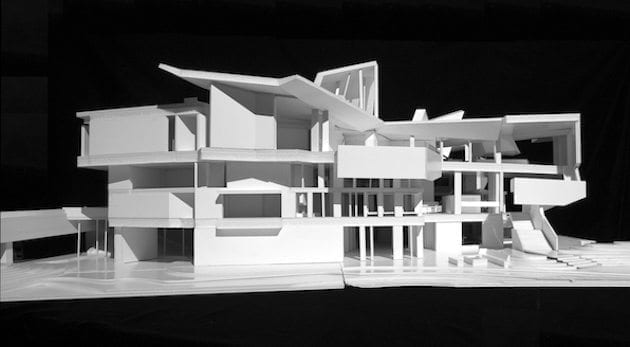
Wang Campus Center, Wellesley College (2001) Photos: courtesy Scogin Elam Architects
COMPETITIONS “One architect, who will remain nameless, took a job as a chair of an architecture program on the east coast, partly because the person thought it might result in some good commissions like Bernard Tschumi at Columbia, for instance. I have to ask Mack if that was an incentive when you became chair of the department at Harvard?
MS:Not in the slightest. If anything, having grown up and knowing the south, that credential has certainly proven not to be something that has brought us attention or work here in this area of the country.
ME: You have to keep in mind that we came from that large firm which had a business development of close to $1M at the time we left. For us to think that going into academia would bring commissions wasn’t on the radar screen. We actually saw this as an opportunity to be around really smart, interesting people, both students and faculty, where we could learn and hopefully broaden our own horizons.
COMPETITIONS: You both must have carried on long discussions about Mack accepting that position…which created a lot of distance from the Atlanta office. I recall Jung Ho Chang (now the Chair at M.I.T.) saying how difficult it was for him to remain at Rice after he and his wife set up an office in Beijing.
ME: With western architects getting the bulk of the work in China now, he (Chang) is exemplary in that he is pulling the Chinese architectural community along and sees that kind of credential as important to the legitimacy of the professional community there.

Exterior view, Jean Jay Hargrove Music Library, University of California Berkeley
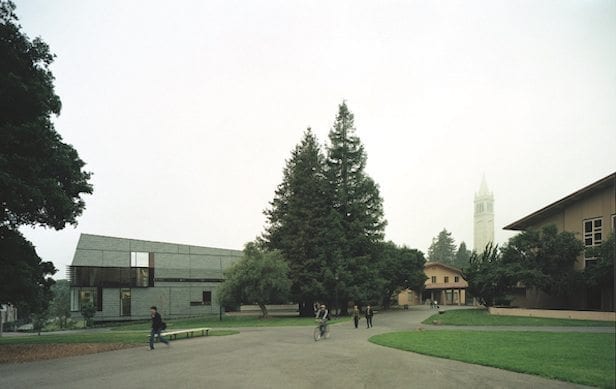
Jean Jay Hargrove Music Library, University of California Berkeley (1998) Photos: Courtesy Mac Scogin Merrill Elam
COMPETITIONS: With Mack in Cambridge and you here in Atlanta, he distance problem apparently was not an insurmountable one, especially carrying on a dialogue about projects. How did you manage to deal with that?
MS: That was easy. We had no work. The early nineties were awful in terms of the marketplace. We really only had one project during those five years (while Mack was Chair at the G.S.D.), which was the library in Tempe. In some ways, the appointment saved us; however, it completely cut us out of any kind of aggressive marketing. In the end, it simply kept the firm going.
ME: We did actually open a small office in Cambridge, but we finally had to close it back down.
MS: Anyone who takes a teaching position with the idea that it is going to raise opportunities to obtain more work is not only possibly mistaken, but also selling the institution a little short. Taking a position like that is a very serious commitment to people that are investing a lot of money in your ability to deliver in a great education program.
COMPETITIONS: In recent years you have been shortlisted in a number of competitions, and there had to be some projects along the way which attracted the attention of those who drew up those shortlists. Is there any one project you can point to which you think raised the firm’s profile?
MS: Thats pretty easy to answer. People who are putting competitions together are looking for a combination of types of people/work to make a short, short list. We invariably get on those shorter lists because we are who we are with this strange background, both in education and in practice and as serious practitioners for almost 40 years now, and the work that we do down here is seen to be a bit idiosyncratic. So we fit into that slot. That is a slot a lot of people are looking for to include in these kinds of processes.
There are also serious issues, i.e., we are practitioners with all that deep experience in making buildings and going through serious processes; yet we are committed to doing the work ourselves. So we are involved in every single project from start to finish. So we can do large projects with a small office. I hope that our work reflects a kind of specificity around particular projects that are taylored to the client that reflects a couple of people that are really interested in listening to clients.
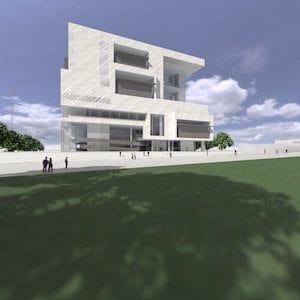
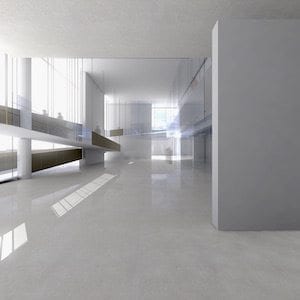
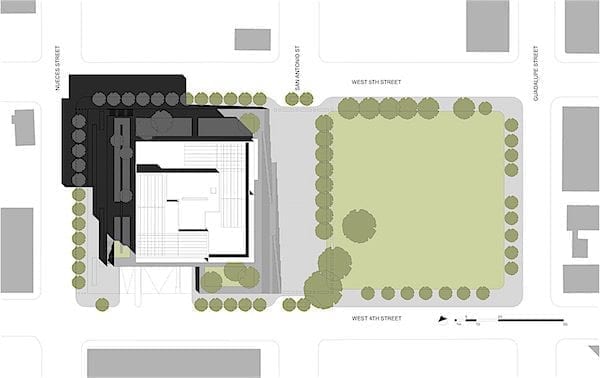
United States Courthouse, Austin (TX) Renderings: courtesy Mac Scogin Merrill Elam
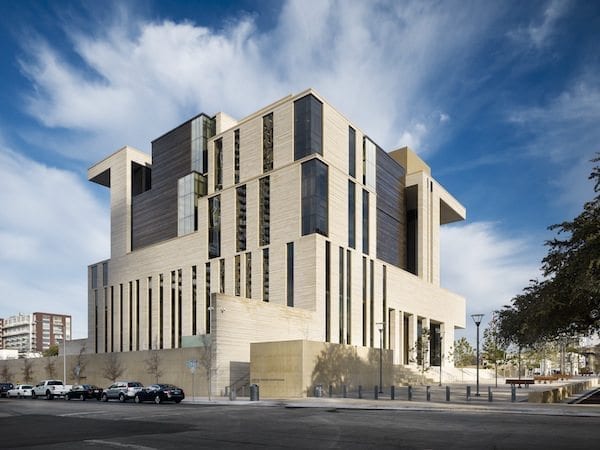
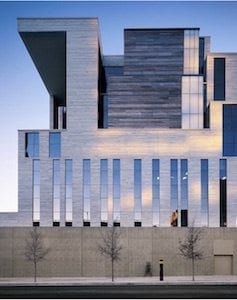


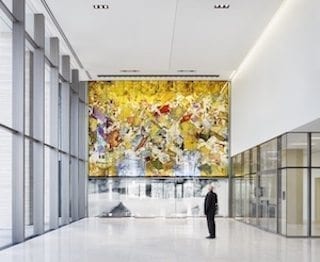
United States Courthous, Austin, TX (2003-2012) All photos: ©Casey Dunn Photography
COMPETITIONS: Was there any one project which you can say brought attention to your firm?
MS: Actually it was never one specific project, it was always the firm’s body of work which turned out to be important. When we started our own firm, and our work got published, it was usually a body of work that was published, never one specific project. We never have had that really high profile public commission (MOMA, Clinton Library, etc.).
ME: What Mack is talking about is general lay-public exposure. Our work has tended to be published more in the architectural press, and we’ve been very fortunate to have lots of architects reference our work and recommend us.
MS: Yes, that ís our market—other architects.
COMPETITIONS: Is there any one competition you have done that may be your favorite?
ME: I still love Fort Lauderdale. That was so much fun. But we do competitions for a lot of reasons. There is always that hope of a commission, but also, we enter competitions to undertake a certain kind of research. It gives us the opportunity to do something that might not be within that normal area where we seek commissions.
MS: Our whole lives as architects has been so wound up in the needs of clients. For so many years that has been ingrained in us: satisfy the clients’ needs. What is fascinating about the competitions process is that it allows us to get outside that norm and to look at things a little differently without that client interaction. Obviously, the competition itself is just the starting point; and that changes once you get a commission. We never see them as solutions: it would be ridiculous to regard a competition submittal as a solution to something. What it does is pose questions to the client as well as back to us.
It puts us in an awkward and uncomfortable position in our traditional professional role. In the end, every competition that we have ever done, has been a learning experience. Of course, that is true for all our other projects as well; but these are more intense learning experiences because we do not have that client looking over the shoulder factor. Competitions can vary a lot. You may have some competitions where you may feel that the client, without even knowing him/her that well, needs an even stronger push. Not only do we push ourselves; but we push their expectations, knowing that doesn’t generally win. There are other competitions, which are much more specifically stated and more specific in the way the criteria are stated. I could go down the list and put each of our competitions into one of those categories. In all cases they are provocations, not solutions.
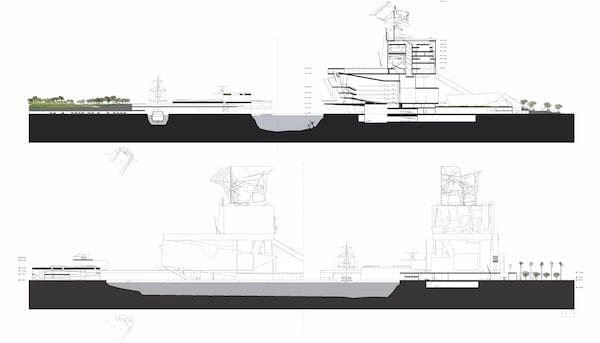
Kaohsiung (Taiwan) Maritime Cultural and Music Center Competition Finalist (2012)
COMPETITIONS: You both got your degrees in undergraduate architecture programs. Masters programs in architecture, such as that at Harvard do not necessarily require an undergraduate degree. In hiring an applicant who has just completed an architecture program, is this a consideration—whether that person comes out of a 5-year or 2-year program?
MS: I’m obviously very prejudiced in this regard, because the school I teach at (G.S.D.) is a 3 1/2 year masters program with virtually no prior background in architecture. Not to say that a 5-year program doesn’t work. On our staff we have people coming from both backgrounds. In the end, it does depend on the individual more than anything else. However, as an educator, having the academic background that provides a broader view of architecture, when you can bring that perspective to architecture is the strongest education you could get for an architect.
COMPETITIONS: You have never been known to shrink from using what some might consider unconventional materials in designing your projects. When you went into the interview for the Ohio State University School of Architecture job, were you already aware of the client’s one precondition—that the cladding be entirely marble? If that was the case, did you already have an idea how you wanted to deal with that? In other words, what was the chronology?
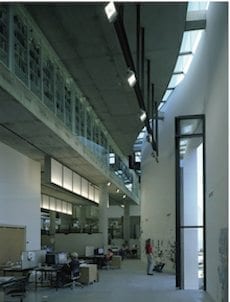
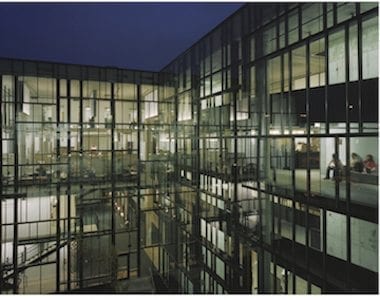
Knowlton School of Architecture, Ohio State University (1999/2003) Photos: courtesy Scogin Elam Architects
ME: We knew that the marble columns were a given. When we were asked pointedly in the interview if we could make a home for them, we said yes.”
MS: I don’t recall that marble was mentioned in connection with the facade at the interview; but very shortly thereafter, it did come up. It was kind of, ‘Oh, by the way…’
COMPETITIONS: The idea you came up with, to hang marble as shingles was quite innovative. How was this received?
MS: They were incredibly relieved. Both the university and ourselves tried for several years to convince the donor that marble was probably not the best choice. Part of it had to do with aesthetics. But the real reason was that marble is not a very good building material. It ís a porous material that deteriorates over time. The caulk joints just don’t hold. So we said, if he wants marble, we’ll do marble, but in a way that it can stay there for 100 years. So we came up with a way to do it without any caulk joints, and in a way that it is suspended so that it can move and doesn’t technically weatherproof the building. It’s simply decoration. Because of budget constraints, the pieces kept getting smaller and smaller, so that they could be put up by hand.
COMPETITIONS: There is probably no building type more popular with architects than a library. I noticed in your essay (Merrill Elam) on libraries that you felt that there should always be a kind of mysterious component built into the design, starting with the entrance.
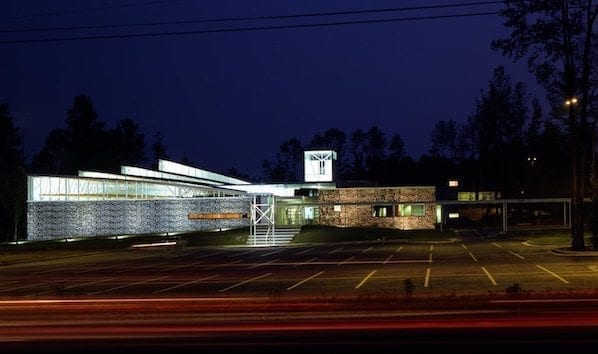
Clayton County Public Library Photo: ©Tim Hursley
ME: I think what I had in mind, was the unfolding of the architectural experience—that you don’t just discover the whole building as soon as you open the front door. There is a sequence of events that would take you to the reading room, or wherever it is you’re seeking out. I know I talked about libraries and architectural character, that they are perfect candidates to be a little bit unusual, because libraries are truly the only real public building we have left. Every other building you enter you get searched, etc. You may not even get in.
COMPETITIONS: Now we have what we call the digital library. Are libraries moving targets as far as design is concerned? Is it still possible to design a library that will be up-to-date 20 years from now.
MS: You are never going to replace books. There will always be a place where you will want to go to experience something very physical. What is interesting about the library now is that it is no longer required to be quiet. This is because the young generation now learns in environments filled with distractions. Starbucks is the great example. That in itself changes the character of the library, not to speak of the computer. There is something different about the immersion factor with a computer than with a book.



























